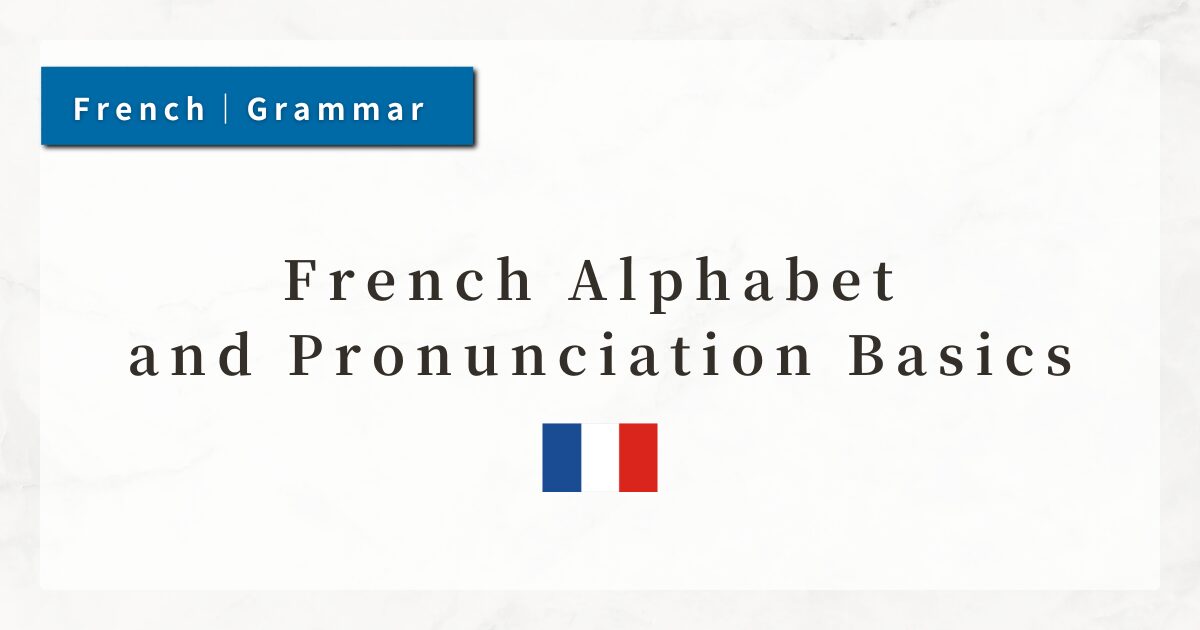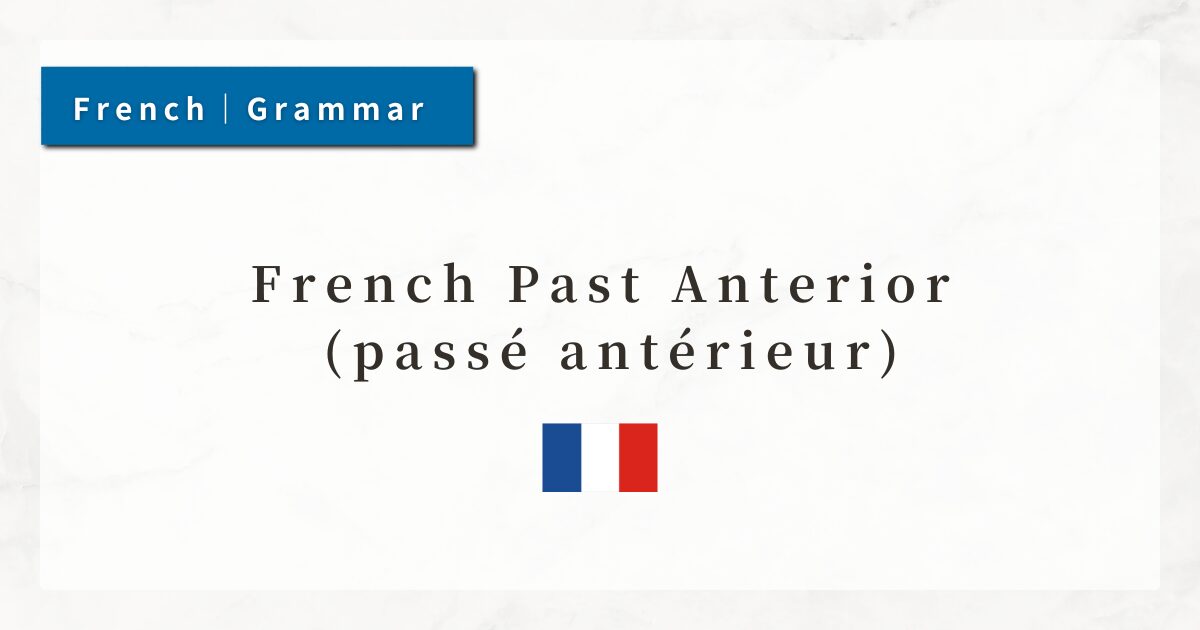#1 French Alphabet and Pronunciation Basics | Complete Guide for Beginners

French pronunciation contains many features that do not exist in either Japanese or English, making it a major hurdle for beginners.
We will start with how to read the alphabet, then move on to vowels, consonants, nasal vowels, silent letters, and the role of accent marks, to help you master the fundamental sounds of French.
The purpose of this lesson is to build a solid foundation for accurate pronunciation.
1. What Is the French Alphabet?
The French alphabet consists of 26 letters, just like English.
However, the way each letter is pronounced differs from English, and there are numerous rules about how letters are pronounced within words.
1-1. French Alphabet List and Pronunciation
| Alphabet | Notes / Features |
|---|---|
| A | Similar to “ah” in English but with a slightly wider mouth opening |
| B | Pronounced clearly |
| C | Followed by a/o/u → “k”; followed by e/i → “s” |
| D | Softer than in English |
| E | Alone sounds like “uh”; varies greatly within words |
| F | Nearly identical to English |
| G | Followed by a/o/u → “g”; followed by e/i → “zh” |
| H | Silent letter (never pronounced) |
| I | Close to Japanese “i” but sharper |
| J | Similar to “zh” sound; different from Japanese “ji” |
| K | Rare in native French words |
| L | Tongue touches the gum ridge |
| M | Same as in English |
| N | Connects to nasal sounds |
| O | Pronounced with rounded lips |
| P | Pronounced clearly |
| Q | Usually followed by “u” and pronounced “k” |
| R | French throat sound; requires practice |
| S | Between vowels, may sound like “z” |
| T | Softer than English “t” |
| U | Lips rounded; between “i” and “u” |
| V | Voiced sound like English “v” |
| W | Close to English “w”; common in loanwords |
| X | At word end “ks”; in middle “gz” |
| Y | Functions as a vowel; variant of “i” |
| Z | Stronger sibilance than English |
2. Examples of Words and Alphabet Pronunciation
| Word | Pronunciation (IPA) | Explanation |
|---|---|---|
| Bonjour | [bɔ̃ʒuʁ] | b = [b], ou = [u], r = throat sound [ʁ]; on = nasal vowel [ɔ̃] |
| Merci | [mɛʁsi] | e = [ɛ] (open “e”), r = [ʁ], i = [i]; shows frequent sound changes |
| École | [ekɔl] | é = clear “e”; final e lightly pronounced or silent; stress on last syllable |
| Chat | [ʃa] | ch = [ʃ] (“sh”); unlike English “chat” |
| Ville | [vil] | ll = [l]; final e usually silent but may link to following word (liaison) |
2-1. The Basic Rule: “Write It, Don’t Pronounce It” at Word Endings
French spelling and pronunciation correspond in relatively regular ways.
For example, “ch” = [ʃ] (“sh”), “ou” = [u] (“oo”), “oi” = [wa] (“wa”). Once you know the patterns, you can often read unfamiliar words correctly.
Compared with English, French pronunciation rules are relatively consistent.
2-2. Final Consonants
In many French words, final consonants are not pronounced. This is very different from Japanese and English, and can feel strange at first.
- paris → [paʁi]
— final s is silent - petit → [pəti]
— final t is silent - grand → [gʁɑ̃]
— final d is silent; nasal vowel present
However, when the next word begins with a vowel, a process called liaison occurs, linking the final consonant to the following vowel.
- les enfants → [lez‿ɑ̃fɑ̃]
— the z is pronounced.
Liaison will be covered in detail in a later lesson.
2-3. Final “e” (e muet)
Many French words end with “e,” but it is usually silent. This is called “e muet.”
| Word | Meaning | Pronunciation | Explanation |
|---|---|---|---|
| fille | girl | [fij] | final e is silent |
| table | table | [tabl] | final e is silent; final consonant remains |
In poetry, song, emphasis, or with liaison, “e muet” may be pronounced.
3. H (h muet / h aspiré)
In French, h is never pronounced, even at the beginning of a word.
In English it corresponds to an audible “h,” but in French it is silent.
- homme (man) → [ɔm]
— h is silent, pronounced “om” - hôtel (hotel) → [otɛl]
— h is silent, pronounced “otel”
3-1. Two Types of “H”
| Type | Feature | Example |
|---|---|---|
| h muet | Treated like a vowel → liaison possible | homme, hôtel |
| h aspiré | Pronunciation is still silent; no liaison | haricot, héros |
You cannot tell which type of “h” it is from spelling; check a dictionary.
4. Nasal Vowels (Vowel + n/m)
French has nasal vowels, which do not exist in Japanese.
When a vowel is followed by “n” or “m,” the sound is produced through both the mouth and the nose.
| Spelling | IPA | Example |
|---|---|---|
| an, en | [ɑ̃] | enfant |
| on | [ɔ̃] | bon |
| in, ain | [ɛ̃] | vin |
| un | [œ̃] | un |
5. Accent Marks and Their Effect on Pronunciation
Accent marks in French affect both meaning and pronunciation.
| Mark | Name | Pronunciation Change | Example |
|---|---|---|---|
| é | accent aigu | clear “e” | école |
| è | accent grave | open “e” | très |
| ê | accent circonflexe | longer “eh” | fête |
| ë | tréma | separates two vowels | Noël |
| ç | cédille | c → “s” | français |
Even the same “e” changes sound depending on the accent.
- été (summer) → [ete]
- être (to be) → [ɛtʁ]
6. Summary
- The French alphabet has the same 26 letters as English, but pronunciation differs significantly.
- Most final consonants are silent, except in liaison.
- Final “e” (e muet) is generally silent.
- Initial “h” is never pronounced, but differs in liaison rules.
- Accent marks are important for both meaning and pronunciation.




